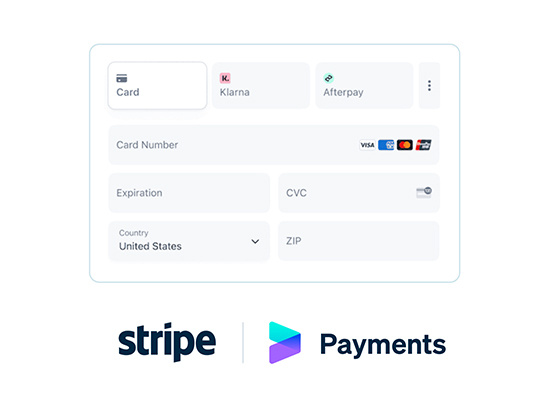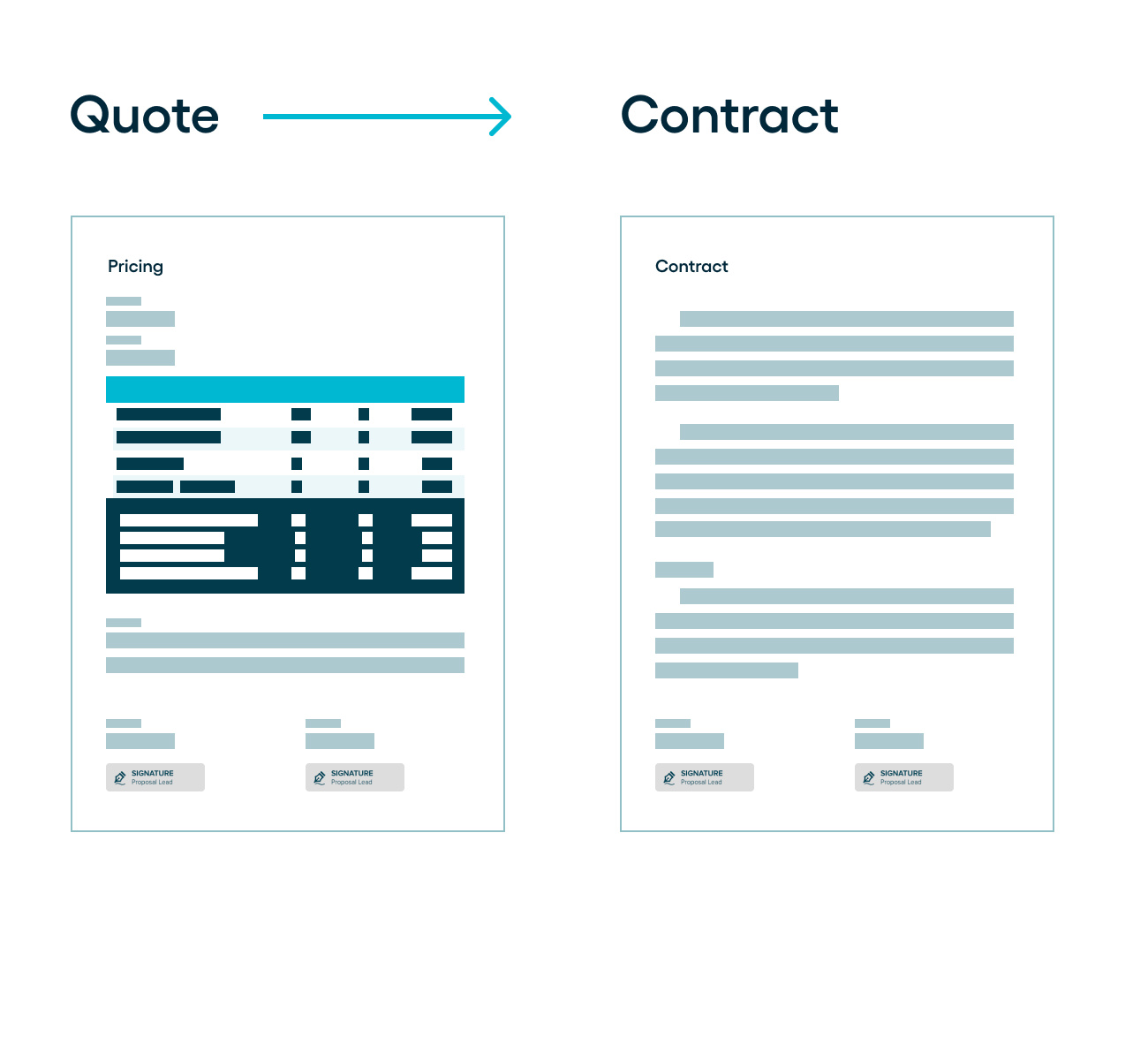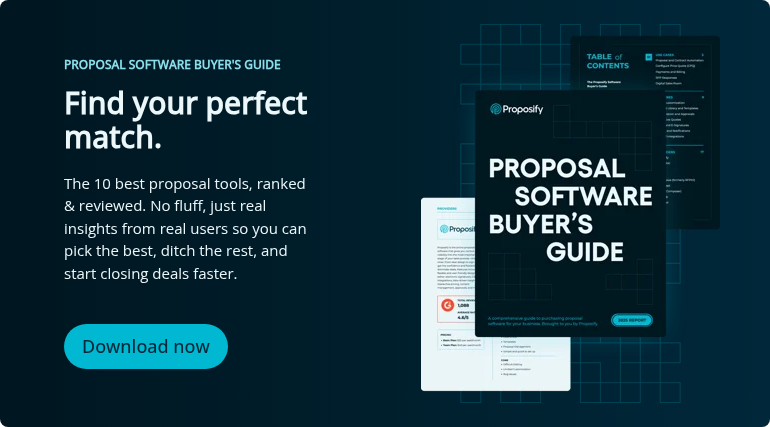Choosing the Best Proposal Software: Features, Benefits, and Tips
Published: October 26, 2021Updated: March 13, 2025
%201x.png?width=760&height=550&name=Best%20Proposal%20Software%20(Textured)%201x.png)
Business proposals are your reps’ best, and sometimes final, chance to seal the deal. They help prospects see the value in your offering, explain why your solution is the best one, and lay a clear path towards a successful working relationship. With so much hinging on getting them right, sending proposals manually is no longer sufficient. There’s really no excuse in this day and age not to use proposal software.
Proposal software takes the guesswork out of the proposal creation process, giving your reps the control and visibility they need to keep deals moving. Plus, it makes the closing process infinitely more consistent, predictable, and scalable. With the right proposal management software at their fingertips, your team can stop spending so much time on proposals and start spending it on winning more deals.
But finding the right solution is easier said than done. Competition to create the best online proposal software is heating up. There are dozens, if not hundreds of providers that all claim to have the best proposal software on the market.
While there are options for everyone, finding the right one can be tough. Here’s how to cut through the noise and choose the best business proposal software for your needs.
Features and Benefits
You already know the best proposal management software makes sending proposals easier, faster, and more consistent, but you might not know how. While the exact capabilities can vary from provider to provider, there are a few key ways proposal software makes your reps’ lives easier.
In order to get the most out of your search for the best proposal software, you’ll need a strong understanding of what it can do.
Proposal Templates
Whether your team uses Microsoft Word docs, Google docs, PDFs or other conventional software, there’s a good chance they’re starting each proposal document from scratch. That's fine if you have all the time in the world. But most teams don’t.
Not only that, creating every proposal individually leaves a lot of room for inaccuracies, inconsistent branding, messaging and pricing, and other errors.

With proposal management software, reps get access to proposal templates that give them a head start on their proposals. So instead of starting with a blank page, they’ll already have the layout, relevant sections, and other important details in front of them each time they start a proposal.
Templates also reduce errors, maintain branding consistency, and ensure accuracy in every proposal. They also help reps save time so they can create proposals more quickly and close more deals.
Automation
If your reps are manually building every proposal from scratch, pulling contact info from old documents and emails, pricing info from the product team, and meeting availability from their calendars into a new proposal is time consuming and prone to errors. Not to mention, some things can be missed along the way.
Proposal automation can help your team skip the manual inputs and increase efficiency by eliminating those tasks, and instead automatically pulling information from other areas of your organization right into proposals.
Content Library
If your sales reps are left to run free, it’s hard to know what’s going into their proposals. Outdated information and incorrect pricing info are just two of the many common culprits, but there are plenty of other things that can go wrong if reps don’t have a central place to pull content from.

With proposal software, you can create a library of pre-approved, up-to-date content so you can be sure that all reps are using the right info, which also contributes to brand consistency.
Deal Management
Struggling to track deal progress after proposals are sent? Proposal software can help. It gives you a bird's eye view of your pipeline, helping you see what stage deals are in, who’s involved, what needs to be done next, and when to step in to push the deal along.
Plus, it gives both sales teams and prospects a way to check in on the status and progress of projects to ensure they’re on track for goals, launches, or other timelines.
Approval Workflows
While we don’t know the specifics about your proposal creation process, if it’s anything like ours, multiple stakeholders are involved. From securing the signoff on pricing to getting the green light to get the business proposal out the door, there are plenty of steps that can cause delays if your team doesn’t have an efficient deal approval workflow.
Proposal software helps you create a streamlined approval process that doesn’t involve digging through multiple document versions, chasing down input from managers, and bouncing documents around different departments.
Instead, your team will collaborate on a single live version that only gets presented to relevant “approvers” when their input is required. With proposal management software, your deals are always moving instead of bottlenecking your process as you wait for approvals.
Electronic Signatures
Did you know that proposals with e-signatures are 3.3X times more likely to close, while also closing 30% faster? Neither did we, until we dug into the data behind them. To nobody’s surprise, electronic signatures significantly reduce friction in sales by making it easier for your potential client to officially seal the deal.

And the best part is that you don’t need to go outside your proposal app to take advantage of them; the best proposal software solutions have eSignature functionality baked right into the platform, meaning your reps can close deals as smoothly as they send proposals.
Analytics
We’d be willing to bet you use analytics to measure almost every aspect of your sales and marketing efforts. But do you use it for closing deals?
The best proposal writing software rounds up all of the proposal analytics generated every day, organizes it, then breaks it down into actionable insights. Gone are the days of wondering about things like whether the champion opens the document or how much time they spend in each section, and how to change or replicate the process in the future.

By putting your data to work, sales analytics give you and your team the knowledge to make better-informed decisions.
Integrations
In the lead-up to the proposal stage, sales teams often use a number of other applications to guide them through the sales cycle. Through integrations, proposal software can connect directly to those applications to create a seamless link between the two.
Whether that’s a CRM to streamline deal stages or Stripe to accept payments directly from proposals, integrations can help your sales team leverage tech to their advantage.
Aside from software features, there are a few other things to take into consideration when making your choice.
How to Choose Proposal Software
It’s no secret that proposal software is a secret weapon, but with so many options at your disposal, it can be tough to pick the right one for the situation. The truth is, every business has different needs, so there’s no one-size-fits-all solution when it comes to proposal software.
Knowing what proposal software is capable of, you’ll want to identify your needs before you start searching for a provider.
Look for the Right Features
Not all proposal software is created equally. Features and functionality can vary significantly from one software solution to another, but that doesn’t mean you should have to compromise.
The best proposal software should offer all the features you need right out of the box, or with the help of integrations. If things like consistent information, faster proposals, and visibility over your deals are important to you (and they should be!), look for proposal software that offers a content library, proposal templates, and an activity feed.
If you want to incorporate videos, interactive pricing tables, eSignatures, or any other feature that helps you create that winning business proposal, hold out until you find a solution that has it all—like Proposify.
Compare Pricing
Like most SaaS products nowadays, many online proposal creation websites charge a monthly subscription fee to use their service. That said, there are still some providers that offer standalone proposal software that can be purchased outright.
Proposify offers three pricing tiers so you can choose the plan that works best for your business. In any case, you’ll want to compare pricing (and pricing models) between providers in order to find the most cost-effective solution for your budget.
Check the Usability
At the end of the day, the best proposal software is the one that works best for your reps and organization. After all, your reps are going to be the ones using the software most often.
Be sure to look into the user experience and usability of each proposal software you consider, otherwise you risk reps wasting time or making mistakes on their proposals. If possible, book a demo with the provider to get an inside look at how the software works and find out whether it would be right for your team. Proposify offers a free demo to show you just how easy it is to use.
Check Whether it Fits with Your Existing Tech Stack
If your team uses a number of other applications throughout the sales cycle, the best proposal software is one that offers all of the integrations you need, like Proposify does. Without them, reps will be stuck pulling information manually between spreadsheets, proposals, project management platforms, and any other essential tools.
In your search for the right proposal tool for your sales team, ask potential providers if their solution integrates with other popular software, and if so, which ones.
Look for Support
In the event your business requires support from your provider, you should choose a solution that makes you feel confident you'll receive the help you need. And you couldn't ask for better support than you get with Proposify.
Whether you need additional guidance with your new software solution, help resolving an issue related to the software, or just an open line of communication, we're here to help. But whatever proposal software you choose, make sure it offers adequate support.
Look for a Knowledge Base
Hands-on support and prompt customer service are important considerations when choosing a proposal tool for your team, but some providers go above and beyond. If you're looking to level up your proposal process, look for a provider that offers additional resources designed to help your reps create the perfect business proposal.
Reach out or dig into your potential provider’s website to find out whether they have a community forum and blog, plus any best practices, ebooks, or other resources that can help take your proposal creation process to new heights.
Check for Custom Services
Custom professional services are a less common feature some proposal software providers offer. If you’re looking for something a little more bespoke to suit your business and your process, this can be a fantastic place to start. And we're happy to say, Proposify offers custom proposal template design service.
A small investment gives you access to professional designers and business proposal experts who deal with deal docs day in, day out. They can leverage their expertise in proposal creation to develop completely custom proposal templates, optimize existing templates, or transform your most important PDFs into an editable format.
With their help, you’ll be able to ensure that your branding is always on point and your processes are seamless so that you can focus on closing.
Proposal Software Use Cases
So how can you make proposal software work for you? We've got a couple of ideas.
Proposal and Contract Automation
Proposal and contract automation makes it easy to create, manage, and send out proposals and contracts fast, without a ton of manual work. By using templates, ready-made content blocks, and workflow automations, your reps can cut down on the time it takes to draft these essential documents. Plus, automation keeps things consistent—branding, legal language, pricing—all while reducing errors that can creep in when doing things manually.

Automated software can even handle follow-ups, like sending reminders for approvals or signatures, so you don’t have to keep checking in. This is especially handy for teams dealing with lots of proposals or contracts, like sales, legal or procurement.
Businesses that need to send out similar proposals or regularly updated contracts—like agencies, SaaS companies, and B2B service providers—will see the biggest benefits. Automation keeps the document creation process moving smoothly, freeing up teams to focus on closing deals instead of getting bogged down in paperwork.
Payments and Billing
Payments and billing features in proposal software make it super easy for your organization to collect payments and manage invoices all in one place.
With this functionality, prospects can review, approve and pay for services or products right after signing the proposal, thanks to integrated payment gateways like Stripe or PayPal. It cuts out the need for extra billing software and speeds up the payment process, making things smoother for both your team and their prospects.

This feature is especially helpful for service-based businesses, agencies, and companies handling recurring or one-time payments tied to proposals. It simplifies billing, reduces payment delays and helps with cash flow.
Plus, if you want to offer flexible payment options (like payment plans or one-click payments), you'll find it enhances the customer experience and makes the payment process frictionless.
Electronic Signature
The ability to electronically sign proposals means you can get quick, legally binding prospect signatures from any device, anywhere, anytime.
E-signatures do away with the need for printing, plugins, downloads and scanning. Everything is done digitally, and you'll be able to manage multiple signatures effortlessly, even from unknown signees. And mobile-friendly capabilities make document sign-off even easier.

Most importantly, you can stay compliant with essential regulations, providing peace of mind and trust in the legality and recognition of your digital signatures. Not only that, you can maintain a comprehensive audit trail of all document e-signing activities, ensuring compliance and providing clear records for verification.
If you're looking for automation and efficiency, you can connect your team’s proposals with CRM software. Create, send, track, and close deals right from your CRM, operating from your single source of truth.
Overall, e-signatures make things easier on your reps and your prospects, allowing deals to close more quickly and more often.
Interactive Quoting
No more costly pricing errors. That's just one of the things interactive quoting offers. First, you'll store and organize the most up-to-date pricing in your fee library. Then, with advanced search, filter, and sorting capabilities, reps can quickly build accurate, customized quotes.
A visual editor allows reps to quickly create professional, branded quotes, ensuring that every quote reflects your company's high standards and brand identity.

You can also get ahead of the competition with a flexible discounting feature. Easily manage discounts at both the quote and line levels, whether it’s based on volume or special prospect agreements, to make your deals even more appealing.
Avoid bottlenecking your sales cycle while still staying on top of your team’s quotes with an approvals workflow that integrates seamlessly into your existing processes. Interactive quoting supports various pricing models to cater to one-time, recurring, and other item categories, making your quoting process as versatile as your business.
Contract Management
Providing consistent and accurate contracts is essential when customizing contracts for individual deals and prospects. You can ensure that consistency and accuracy with contract management. You'll also save time by setting up reusable contract templates complete with standardized, pre-approved clauses.
Contract management makes collaboration simple and keeps everything accurate with easy editing tools. Everyone involved can quickly review, fine-tune, and finalize contracts, making sure all parties are on the same page.

A contract content library makes it easy to store, organize, and search clauses, snippets, and other pre-approved content. Sales reps can quickly access the content they need and drop it into contracts without needing to start from scratch with every agreement.
You'll also be able to stay on top of your contracts with custom alerts and reminders. For example, you can receive notifications about important milestones and document activity, so you never miss a deadline or fall behind schedule.
With contract management, you can send documents to the right people at the right time for edits and sign-offs, so everything gets done quickly and accurately before reaching stakeholders.
The Best Proposal Software
The final step in choosing the best proposal software is knowing some of the options available to you. We could fill page after page with those options, but we're going to focus on the top five because we know you're busy and you'd probably prefer to get right to it. So here we go!
Proposify
Now, we’re clearly a little biased. But we think Proposify is pretty great. Don’t just take our word for it, though! Our fans on G2 have us blushing by consistently ranking us among the best proposal software on the market.
 Proposify’s proposal builder is being improved upon all the time so that the drag-and-drop functionality is reliable. Our competitive edge lies in that design flexibility, and in our new automations, which allow you to build automated workflows right inside Proposify without relying on paid external tools like Zapier.
Proposify’s proposal builder is being improved upon all the time so that the drag-and-drop functionality is reliable. Our competitive edge lies in that design flexibility, and in our new automations, which allow you to build automated workflows right inside Proposify without relying on paid external tools like Zapier.
Proposify also offers automated email follow-ups that can be triggered at the time of sending in just a few clicks. Where Proposify needs a little more development is with RFP responses, sales rooms and CPQ, all of which we plan to add, so stay tuned!
PandaDoc
PandaDoc aims to take the work out of document workflow. It offers a suite of tools designed to help sales teams create, send, and manage proposals and other sales documents.

It’s an affordable solution for sales teams looking to streamline their proposal process, but it does have one major drawback: Unlike Proposify, proposals created with PandaDoc are pretty simple—they look just like regular documents as opposed to interactive, enticing proposals. In addition, PandaDoc doesn't offer the same design flexibility or robust customer support that Proposify does.
Qwilr
Like the other solutions on this list, Qwilr empowers users to create proposals more efficiently. But instead of sending prospects a PDF or live document, proposals are delivered in the form of an interactive web page. This allows sales teams to create more immersive experiences with embedded elements such as Google Maps, calendars, videos, and more.

But as impressive as the final result may be, some businesses do still prefer to send their prospects a simple PDF proposal. And if you choose this solution, you won’t have that option.
Loopio
While Loopio is a powerful proposal software option, it's geared more toward request for proposal (RFP) responses than unsolicited sales.
One of the strongest features it offers is automation to respond to RFP questions, which can save your sales team a lot of time. The magic response feature uses AI to learn from your company's content so responses are on-brand and accurate.
However, if you're not looking to automate those kinds of repetitive RFP tasks, Loopio may be unnecessarily expensive.
Responsive
Responsive (formerly RFPIO) is a cloud-based response management platform also geared toward making RFP responses easier. It's designed to improve efficiency, accuracy, and collaboration for teams dealing with complex proposal responses.

The platform offers robust collaboration features that allow team members to work together seamlessly, regardless of their location. It also supports a wide range of file formats for import and export, making it easy to work with documents in their original formats.
Much like Loopio, Responsive also falls on the more expensive side of the spectrum, so it may be too much tool for smaller businesses creating smaller proposals.
Get the Features You Need with Proposify
Ready to choose the best proposal software? Consider Proposify. It has the features your team needs to build effective proposals and close more deals. Our proposal software gives you total control and visibility into your proposal process, from start to finish.
Start a free trial or schedule a demo today, and see how you can improve your entire sales process.

Michelle Lowery is a B2B and B2C writer and editor with more than 15 years of experience. She believes empathy is the key to high-performance content. Connect with her on LinkedIn:




